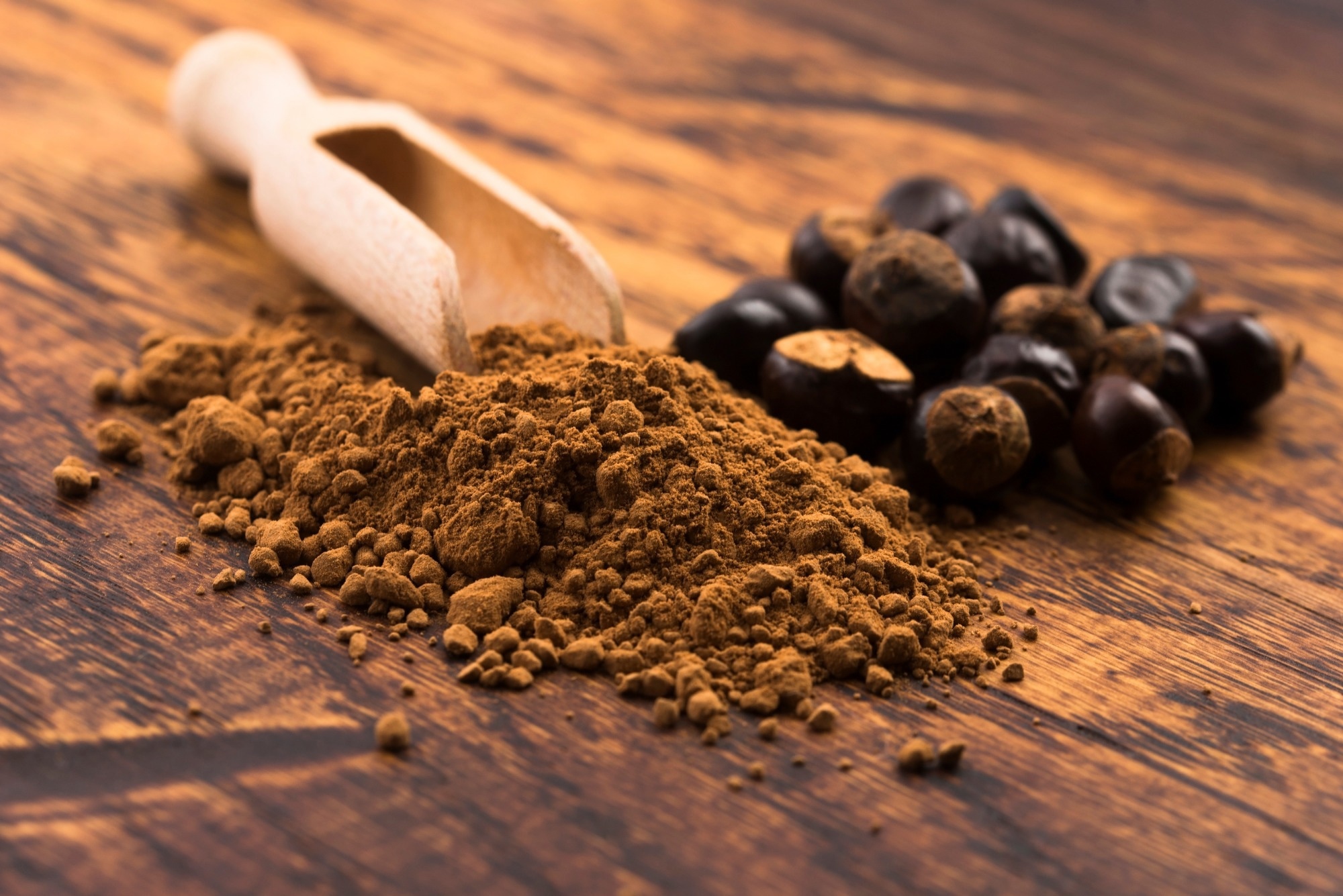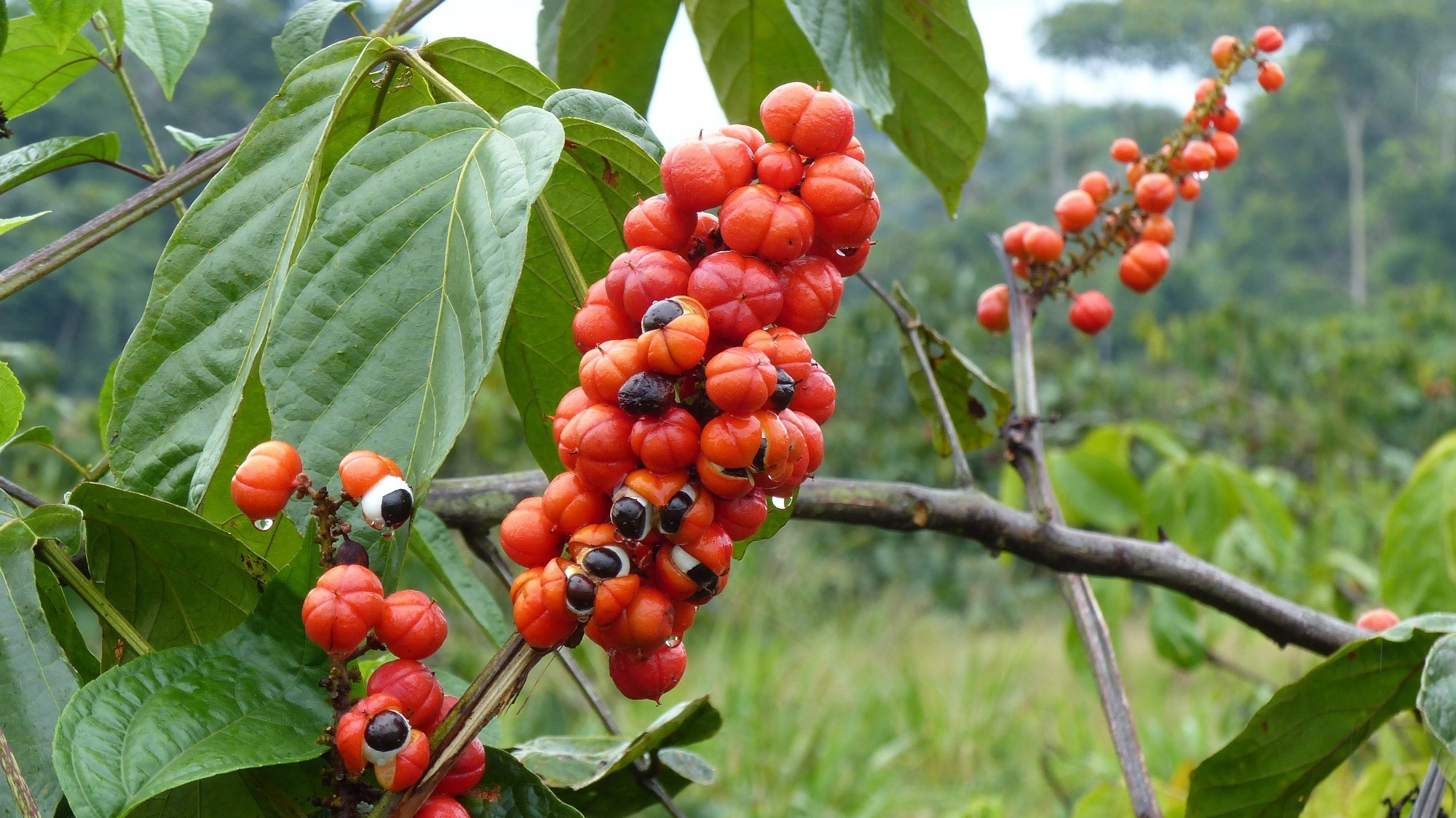Introduction
Phytochemical composition
Pharmacological mechanisms
Cognitive health applications
Metabolic health applications
Safety, dosage, and regulatory considerations
Future directions
Conclusions
References
Further reading
Explore how guarana’s potent mix of caffeine and polyphenols is driving research into its role as both a metabolic modulator and a cognitive enhancer, uncovering its promise and the gaps that remain for its use in functional nutrition.
 Image Credit: joanna wnuk / Shutterstock.com
Image Credit: joanna wnuk / Shutterstock.com
Introduction
Paullinia cupana Kunth, more commonly known as guarana, is a climbing plant native to the Amazon basin and is especially prevalent in Brazil. Traditionally, guarana seeds have been utilized in indigenous medicine to enhance stamina and alleviate various conditions, including headaches, fevers, muscle cramps, and symptoms related to heat stress.
The seeds are notable for their high content of caffeine and other bioactive compounds, including theobromine, tannins, saponins, and catechins, which contribute to their stimulant and purported therapeutic properties. The plant is primarily cultivated in the Amazon rainforest, with Brazil being the leading producer.
Guarana extract is a key ingredient in numerous flavored soft drinks and energy beverages, particularly popular in South America. It is increasingly incorporated into dietary supplements worldwide due to its perceived benefits in cognitive performance, alertness, and physical endurance. In addition to its stimulant effects, emerging research has explored the potential antioxidant, antimicrobial, and metabolic health benefits of guarana, further supporting its global use as a functional ingredient.1
Phytochemical composition
The dry weight of guarana seeds has a caffeine content between 2.4% and 5.1%, in addition to small amounts of theobromine and theophylline. Guarana seeds are rich in polyphenols, 5-14% of which include condensed tannins and catechin-type flavanols, as well as saponins, trace polysaccharides, and fatty acids.
Traditional guarana seed drinks can contain more natural caffeine per serving than typical coffee or tea preparations, which makes this seed the world’s most caffeine-rich beverage. The tannins and saponins present within guarana seed reduce the rate of caffeine absorption, thereby prolonging its effects on attention. Catechin-rich polyphenols also work synergistically with caffeine to increase its antioxidant and thermogenic effects.
Pharmacological mechanisms
Guarana seeds contain caffeine, theobromine, and theophylline, which stimulate the central nervous system (CNS) by acting as antagonists to the adenosine receptor, thereby reducing fatigue and enhancing alertness. The caffeine rich content of guarana seeds have led to its widespread use as a stimulant in beverages and functional products.2
The flavonoids present in guarana seeds can activate the nuclear factor erythroid 2-related factor 2 (Nrf2) signaling pathway, which subsequently increases the levels of superoxide dismutase (SOD), catalase (CAT), and heme oxygenase 1 (HO-1). Non-selective phosphodiesterase 4 (PDE4) inhibition increases cyclic adenosine monophosphate (cAMP), thereby reducing tumor necrosis factor α (TNF-α) levels and promoting protein kinase A (PKA) signaling.
Guarana polyphenols inhibit alpha glucosidase, support insulin sensitivity, and reduce low density lipoprotein (LDL) oxidation. These effects collectively support the improvement of lipid metabolism, which in turn enhances cardiometabolic and cognitive health in diverse populations.2
Have you heard of GUARANA?! A superfruit native to the AMAZON that is transformed into SODA!
Cognitive health applications
Evidence for guarana as a cognitive health aid is mixed. For example, improved mood, alertness, or secondary memory has been reported in several trials, particularly those using formulations that combine guarana seed with Panax ginseng or vitamin-mineral complexes.
Comparatively, a recent systematic review and meta-analysis did not identify a significant overall cognitive advantage associated with guarana seed supplementation. However, a slight and reliable improvement in response time was observed across attention and memory tasks, without consistent gains in accuracy.3
Many published studies that have previously investigated the cognitive impact of guarana seed are associated with numerous limitations that prevent the generalizability of their results. These include variable co-ingredient content, dose, and testing times, as well as small sample sizes, incomplete reporting, and possible ceiling effects.
Thus, larger, well-controlled, caffeine-matched, and multi-dose trials that include mood, anxiety, and real-world fatigue endpoints are needed. Until these data become available, guarana seed should be considered a modest task-specific stimulant, rather than a proven broad-spectrum cognitive enhancer for attention, mood, or fatigue.3
Metabolic health applications
Eight-week administration of guarana seeds prevented weight gain in high-fat and hyperlipidemic in vivo models, increased oxygen consumption and energy expenditure (EE), and limited white fat accumulation. Guarana seed treatment also increased brown adipose tissue (BAT) levels and thermogenic signaling, including sirtuin 1 and uncoupling protein 1 (UCP-1) through AMP-activated protein kinase (AMPK).4
Guarana seed supplementation appears to reduce fasting glucose, triglycerides (TG), hyperinsulinemia, and low-density lipoprotein cholesterol (LDL-C) levels and, in some cases, improve insulin resistance. These effects typically occurred with minimal change in appetite or food intake, which suggests a metabolic mechanism.
In addition to preclinical data, an elderly Amazonian cohort that habitually consumed guarana seeds was less likely to develop hypertension, obesity, and metabolic syndrome. Nevertheless, rigorously controlled human trials are needed to confirm these metabolic effects.4
Safety, dosage, and regulatory considerations
Guarana-derived caffeine is considered safe to consume when daily caffeine intake remains below 400 mg and single servings under 200 mg. Previously, 75-300 mg guarana extract supplementation for up to six weeks did not cause any significant changes in vital sign measurements or liver enzyme levels, which further supports its short-term safety.5,6
Excessive or chronic use of guarana seed may cause insomnia, tremors, palpitations, or hypertension. As a result, individuals diagnosed with uncontrolled cardiovascular disease or anxiety, as well as pregnant or lactating women, should not consume guarana seed.
In the United States, guarana is Generally Recognized as Safe (GRAS), which allows for its incorporation into foods, energy drinks, and dietary supplements within notified limits. The European Food Safety Authority (EFSA) applies the same caffeine thresholds to guarana-fortified products across the European Union.5,6
Future directions
Large, multi-center randomized controlled trials that follow diverse populations for months or years are needed to confirm cognitive, metabolic, and safety outcomes. Mechanistic studies are also necessary to investigate how polyphenols present in guarana seeds interact with the gastrointestinal microbiome and other components of the gut-brain axis.
Reported caffeine and flavonoid levels can vary widely between different guarana extracts, with label inaccuracies of up to 30% and differing bioactive profiles that alter absorption. Thus, standardizing specifications, performing bioavailability studies, and adopting innovative decontamination or formulation technologies are crucial.6,7
 Image Credit: guentermanaus / Shutterstock.com
Image Credit: guentermanaus / Shutterstock.com
Conclusions
Guarana combines high natural caffeine with polyphenols that may modestly improve attention, mood, and reaction speed while supporting thermogenesis, glucose regulation, and lipid balance. Observational data associate habitual intake of guarana with a reduced risk of cardiometabolic disease, with potential mechanisms including adenosine receptor antagonism, antioxidant and anti-inflammatory signaling, and BAT activation. Evidence remains limited by small sample sizes, short follow-up periods, co-formulations, and variable extract standardization.
References
- Leila Larisa Medeiros Marques, Emilene Dias Fiuza Ferreira, Mariana Nascimento de Paula, Traudi Klein, João Carlos Palazzo de Mello. (2019). Paullinia cupana: a multipurpose plant – a review, Revista Brasileira de Farmacognosia, 29 (1), 77-110. DOI: 10.1016/j.bjp.2018.08.007, https://www.sciencedirect.com/science/article/pii/S0102695X18303533
- Effaliza Misran, Fitrien Husin, Alia Natasha Sa'at, Amirah Qistina Harun, Saiful Irwan Zubairi, Harisun Ya'akob, (2025). In silico evaluation of guarana's bioactive compounds for diabetes, inflammation, and oxidative stress: Insights from molecular docking and ADMET profiling, Results in Chemistry, 16. DOI: 10.1016/j.rechem.2025.102394, https://www.sciencedirect.com/science/article/pii/S2211715625003777
- Hack B, Penna EM, Talik T, Chandrashekhar R, Millard-Stafford M. (2023) Effect of Guarana (Paullinia cupana) on Cognitive Performance: A Systematic Review and Meta-Analysis. Nutrients. 15(2). DOI: 10.3390/nu15020434, https://www.mdpi.com/2072-6643/15/2/434
- Clécia Dias Teixeira, Priscila Oliveira Barbosa, Melina Oliveira de Souza, (2024). Effects of guarana (Paullinia cupana) powder on obesity-associated diseases in animal models: A systematic review. Journal of Functional Foods, 112. DOI: 10.1016/j.jff.2023.105944, https://www.sciencedirect.com/science/article/pii/S1756464623005443
- Temple JL, Bernard C, Lipshultz SE, Czachor JD, Westphal JA, Mestre MA. (2017) The Safety of Ingested Caffeine: A Comprehensive Review. Front Psychiatry. 8. DOI: 10.3389/fpsyt.2017.00080, https://www.frontiersin.org/journals/psychiatry/articles/10.3389/fpsyt.2017.00080/full
- Talik TN, Penna EM, Hack BP, Harp A, Millard-Stafford M. (2024). Effects of Acute Guarana (Paullinia cupana) Ingestion on Mental Performance and Vagal Modulation Compared to a Low Dose of Caffeine. Nutrients. 16(12). DOI: 10.3390/nu16121892, https://www.mdpi.com/2072-6643/16/12/1892
- Dionisio Pedro Amorim-Neto, Clara Mariana Gonçalves Lima, Simone de Nazaré Melo Ramos, Raimunda Susielen Ribeiro Araújo, Ana Luisa Perini Leme Giordano, Angélica Zaninelli Schreiber, Anderson S. Sant’Ana, Priscilla Efraim. (2025). The microbiological landscape of guarana production: insights from the Amazon state (Brazil) production chain, Applied Food Research. DOI: 10.1016/j.afres.2025.101162, https://www.sciencedirect.com/science/article/pii/S2772502225004676
Further Reading
Last Updated: Jul 27, 2025